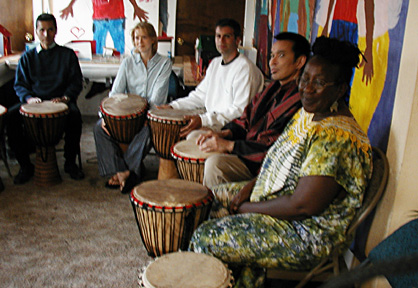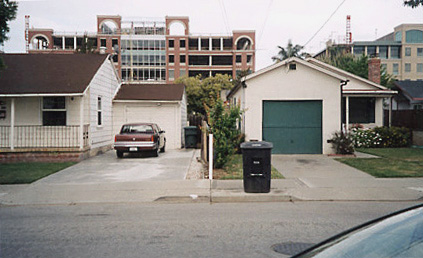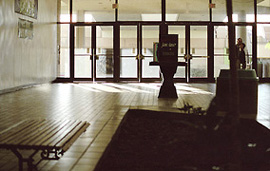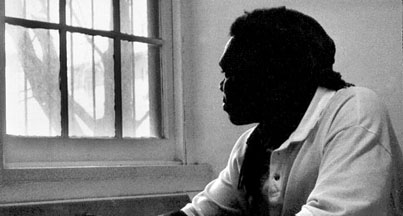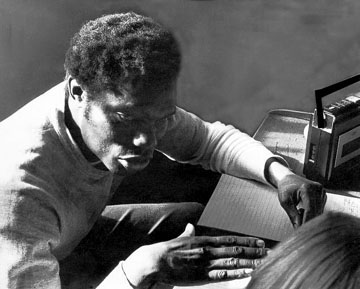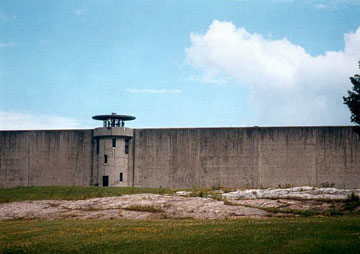
Let’s go, let’s go, let’s go!” chant the thousands of bicyclers in San Francisco’s Justin Herman Plaza. Gathered for the monthly Critical Mass ride, this gleeful mob will pour into city streets after work, stopping traffic, angering motorists, and generally having a good time. Since Critical Mass’ founding a decade ago, the group has emerged in hundreds of cities, from Warsaw to Taipei.
Though some are just along for the ride, many cyclists have anti-car sentiments they wish to make known. “End Petrotyranny,” reads the hand-written sign pinned to the back of one rider. “The war and our car use is completely connected,” he says as he waits for the March ride to begin.
“The auto is bad technology–gasoline, pollution, isolation, war,” rattles off Critical Mass co-founder Chris Carlsson as he taps on the drums and cowbell that festoon his bike. A wire sprouting from his black hat dangles a dollar bill that jumps to his rhythm.
Then, true to the group’s anarchist principles, the riders lumber off spontaneously with no predetermined route or leader. It’s time to take back the streets from those hurtling steel boxes, if only for an evening.
Critical Mass and its like-minded brethern are the public face of the anti-car movement, doing whatever it takes to discourage, annoy, and guilt-trip drivers off the road. For them, the car is the root of most evil, poisoning the environment and chewing up communities. The two- and three-car garage, the parking lot, and the elevated highway have usurped front porches, dense shops, and vibrant downtown hubs. Whether cars are wee Minis or hulking Hummers, they are “big, greedy, and aggressive,” in the words of Charles Komanoff, an activist who works with www.cars-suck.org and the Bridge Tolls Advocacy Project. “They make everything the same, and they crowd out everything else.”
Though contemporary anti-car protest has its roots in 1960s activism, today rebellion foments in policy institutes, environmentalist organizations, fringe political groups, and academia. In the form of Arianna Huffington’s anti-SUV ads and the What Would Jesus Drive? campaign, it even threatens to go mainstream. For the most part, today’s activists have spurned old-school revolutionary rhetoric. They are confronting the beast on its own terms: Armed with economic analysis and appeals to free markets, they hope to slay the dragon of American auto-dependence and usher in an era of clean mass transit and dense, vibrant urbanity.
The theoretical backbone behind opposition to automobiles is the search for the “true cost” of driving. To reverse the transformation cars have imposed on our cities and communities, the argument goes, drivers should pay for the havoc cars wreak. If transportation were priced fairly, anti-car activists claim, people would choose places to live that favor dense, urban areas and relegate the car to occasional family trips and Sunday drives. Although anti-car papers debate the “true cost” of driving–a figure proving to be rather slippery–some critics claim that the anti-car argument is riddled with economic errors and that the debate goes much deeper to basic issues of freedom and coercion.

Anti-car activity?
Surrogate feet
One of the most inescapable papers on the true cost of driving is “Going Rate: What it Really Costs to Drive,” a 1992 paper from the World Resources Institute. “Motorists today do not directly pay anything close to the full costs of their driving decisions,” writes co-author James MacKenzie. The current transportation system, he says, favors cars by providing direct and indirect subsidies to drivers. MacKenzie posits that this produces a distorted, inefficient market and encourages people to drive excessively.
A host of reports from organizations such as the World Resources Institute and the Sierra Club claim to show that automobiles are massively subsidized by both the government and those who bear the costs of pollution, noise, and accidents. The amount of the subsidy varies from $300 billion per year, calculated in the “Going Rate” report, to a staggering $2.1 trillion, as reported by the Sierra Club.
Anti-automobile economists claim that although drivers do pay for their vehicle operating costs and some percentage of road construction and maintenance, they don’t pay for many other costs: roadway land value; municipal services such as highway police that cater to drivers; air, water, and noise pollution; accident costs; resource consumption; land-use impacts; military expenditures in the Middle East to protect oil supplies; and the Strategic Petroleum Reserve. For example, according to the Federal Highway Administration, federal, state, and local disbursements for highways were $129 billion in 2000, while user-fee receipts from fuel and vehicle taxes and tolls totaled only $77 billion. The rest of that $52 billion came from general fund appropriations, property taxes, and “other taxes and fees.” These appropriations comprise a direct subsidy, analysts like MacKenzie say.
Congestion is another large external cost–one not created by a producer or consumer. With free access to the roads at all times, drivers do not have to pay more to drive during commutes, when demand for driving is highest. The result of this “market failure” is traffic jams that wastes the time of drivers, time that MacKenzie estimates to be worth at least $100 billion a year.
In essence, writes Alvin Spivak, author of the anti-car tract The Elephant in the Bedroom, our policy toward the car is like the Soviet policy toward bread: The price is kept so artificially low that over-consumption is bound to occur. According to Spivak, Soviet economics in former President Mikhail Gorbachev’s time made rolls so cheap they were often used as surrogate soccer balls. In the United States, cars have become surrogate feet, Spivak argues–and our use of them has mushroomed out of control because using them seems almost free.
Unable to compete against this giveaway, mass transit, once privatized and profitable, is unable to pay its own way. The government has had to take over and, despite intervention, those hapless souls in America who cannot afford a car are ill served by limping bus and rail systems.
Anti-car papers claim that the solution to these two broken systems–the overused auto and ineffectual mass transit–is to restore the free market to transportation. Whether through an increased gas tax that would push the cost per gallon to anywhere from $2.86 to $16.11 (the range is due to different reports’ findings), congestion pricing, or increased user fees, once people start paying for their use of the roads and the damage they cause to the environment, a whole new pattern of transportation use will emerge.
In Europe, where drivers pay up to three times the amount Americans pay for a gallon of gas, it has not been difficult to implement high gas taxes. Gas taxes are not earmarked for highway and road expenses in Europe, and politicians are more willing to raise the tax to increase general revenue. But in the United States, where gas tax revenue must go toward road projects–though increasingly it is being used for mass transit projects, too–raising the price of driving is a tough sell. Some would argue that the gas tax is a third rail that politicians will never touch for fear of angering a public that considers low gas prices a birthright.
But even if it were politically feasible, some say proponents of an increased gas tax are not necessarily using sound economic analysis, despite their claims of “fair pricing.” In the exhaustive report, “The Annualized Social Cost of Motor Vehicle Use in the U.S.,” University of California at Davis economist Mark Delucchi writes that “there is not a single external cost, with the possible exception of CO2 emissions from vehicles, that in principle is properly addressed by a gas tax.” He argues that the majority of external costs imposed by drivers are not a function of how much gas they use. For example, Delucchi says a gas tax would not be a fair way to compensate for noise pollution because gas consumption is not necessarily related to the amount of noise a car produces. A Harley-Davidson motorcycle or a broken muffler will out-noise a Toyota Camry any day, regardless of gas consumption.

Cutting through downtown.
Driving wherever? Priceless
But even if we could accurately determine all the costs driving imposes on society, would that necessarily mean that driving cars is nothing but one big cost? No, critics argue. As any economist can tell you, cost is just one factor. To properly estimate the worth of something, one must weigh its cost against its benefits–something most anti-car analysts have been accused of failing to do.
“I think they are trying to affect a cultural revolution,” says Roy Cordato, an economist with the John Locke Foundation, explaining why those who argue against cars don’t factor in the benefits they bring. Cordato calls the reports he has read, including MacKenzie’s piece and tracts from the Sierra Club, “intellectually dishonest…hyperbolic at best, and just outright deceitful.” The anti-automobile leaders are so wrapped up in imposing their vision of society on the public, he says, that they ignore contradictory data and sound economic analysis.
Cordato is a self-described libertarian who loves living on an acre-and-a-half while still being able to drive just thirty minutes to his office in downtown Raleigh, North Carolina. Originally from upstate New York, he speaks with northeastern impatience when the subject turns to anti-car arguments. The costs they are trying to measure, Cordato asserts, are not measurable, and the benefits that are supposed to accrue from a full-cost pricing plan are unknowable. “So-called analyses of the full cost of driving,” he says, “can come to any conclusion the analyst desires.”
The problem, argues Cordato, is that anti-car analysts misunderstand or misuse the economic concept of cost, which refers to opportunity costs–the amount of satisfaction foregone by undertaking a certain activity. For example, if someone must choose between going to the beach or the ballgame and chooses the ballgame, the cost of that decision is the value placed on going to the beach. This value is plainly subjective.
To know the costs of driving, then, “the analysts would have to know the subjectively determined preferences of all the individuals whose lives would be affected” by any changes to the current situation. Because this is impossible, says Cordato, any so-called “full-cost analysis” of driving should not be the basis for a policy that would cause the drastic lifestyle changes advocated by anti-car arguments.
Cordato uses the example of an asthmatic to illustrate his point. We cannot say with certainty that someone with asthma is “better off” in a society where a high gas tax, which theoretically will reduce airborne particulate matter, improves her medical condition. Perhaps the asthmatic values the flexibility and freedom she associates with automobiles more than easier breathing. How are we to know this unless we ask her? And how are we to know, in general, what every individual in society prefers?
Further, if advocates of the full-cost pricing scheme are trying to correct for “market failure”–the linchpin concept in their case against the car–why do they advocate more governmental intervention in the form of taxes, other pricing schemes, or mass transit, Cordato asks. “The transportation system is a mess because there is a lack of markets,” he says. This absence of markets produces a supply of roads that does not reflect demand and generates costs such as noise and pollution that users do not pay. But since we have a completely socialized road system–a centralized authority determines where and when roads are built and does not charge users the market value of using the system–we cannot blame the free market for the system’s failure. “The markets have not failed,” Cordato says. “It is the government, which has a monopoly on the road system, which has failed.”

Highway revolt.
Route 66, Inc.?
Cordato agrees that there is an automobile problem. Roads are under- and overused, and cars cause damages for which victims are not compensated. He points to the interstate highway system as an example: “So much of it is just a waste of concrete. You’ve got miles and miles of super-highway that is empty most of the time.” His solution is to take planning out of the hands of the inept government, privatize the roads and have operators charge people to drive on them, which is abhorrent to anti-car activists. Privatization would take politics out of transit choices and leave them up to the consumer, not the lobbyists. Costly, unprofitable enterprises like unused highways, subways, and light rail likely would go bankrupt. Private bus companies would flourish–not a bright prospect for those who want to lessen or even eradicate car use.
For Cordato, central planners and the government can never respond to demand as well as the market, in which millions of individuals make specific economic decisions in incredibly varied situations. When a central authority tries to determine what all these individuals need, then allocate resources and charge fees accordingly, he warns others to be on the lookout for bread-roll soccer balls.
Even if planners could determine what needed to go where and when, special interests would tear their designs apart. Libertarians fear that when you couple these tendencies with the coercive power of the government–eminent domain in the field of town and transportation planning–you have disaster: Just look at the highways that roll through uninhabited ranch lands or have decimated the urban fabric, ripping through neighborhoods in the face of local opposition.
But if roads were privatized, Cordato argues, people would get what they demand. Privatization also would go further in solving the problem of external costs that concern anti-car activists. Whereas now it is virtually impossible to sue the government for pollution caused by the use of its roadways, private companies would not enjoy the government’s luxury of “sovereign immunity” and would have to take issues of harm into account when they plan the construction and operation of roads. If too many people are able to sue a company for the pollution and noise that accompanies the superhighway planned for their backyard, the company probably won’t build it.
What the issue comes down to for libertarians is individual freedom as opposed to the coercive nature of centralized planning. We simply can’t know if society will be “better off” with reduced car use unless we claim to know what is good for all individuals and force that “good” upon them. Only the free market can give individuals what they want without forcing them to comply with the vision of a few far-away planners, argue those who oppose regulating car use.
“Freedom is the one value that allows other values to flourish,” Cordato says. This, he reiterates, is the nut of the debate, something either dismissed or not discussed in anti-car literature. “I want people to get what they want,” he says, with the usual caveat of not allowing the coercion of others. But the anti-car activists, he claims, don’t seem to want that.
Americans have a history of revolting against what Jane Jacobs, in The Death and Life of Great American Cities, called the centralized city planning of “high-minded social thinkers.” This April, residents of San Francisco, home of the first American highway revolt in 1959, tore down some of the elevated highway built across busy Market Street. The lesson seems clear: Far-away authorities and social engineers have no business determining local issues. Are anti-car advocates following the central planning footsteps of the highway builders of yore? If so, the revolutionary visions of the movement could simply lead to more rebellion. In our culture of freedom and choice, utopia may have to be won one driver at a time.
Story Index
MARKETPLACE >
A portion of each sale goes to Inthefray.com
Driving Forces: The Automobile, its Enemies, and the Politics of Mobility
By James Dunn | Brookings Institution Press | 1998
Amazon.com
ORGANIZATIONS >
Bridge Toll Advocacy Project
URL: http://www.bridgetolls.org
New YorkCar Busters
URL: http://www.carbusters.org
Prague, Czech RepublicCars Suck
URL: http://www.cars-suck.org
New YorkCritical Mass
URL: http://www.critical-mass.org
Worldwide
Note: There is no official Critical Mass web site; this is just one of many sites devoted to the rideFederal Highway Administration
URL: http://www.fhwa.dot.gov
Washington, D.C.John Locke Foundation
URL: http://www.johnlocke.org
Raleigh, North CarolinaVictoria Transport Policy Institute
URL: http://www.vtpi.org
Victoria, British Columbia
A wealth of information on transportation issues, including a huge annotated bibliography on transportation at URL: http://www.vtpi.org/bib.xlsUniversity of California Transportation Center
URL: http://www.uctc.net
Berkeley, California
Download or order scholarly articles on transportation issues, often at no charge.World Resources Institute
URL: http://www.wri.org
Washington, D.C.
Published the influential report “The Going Rate: What It Really Costs to Drive.”
TOPICS > COST OF DRIVING >
“America’s Autos on Welfare”
URL: http://www.sierraclub.org/sprawl/articles/subsidies.asp
Sierra Club | 1996
A summary of the economic analyses of the cost of driving.“The Annualized Social Cost of Motor Vehicle Use in the U.S., 1990-1991”
URL: http://www.uctc.net/papers/311.pdf
By Mark Delucchi | Institute of Transportation Studies | 1997
The above link is to an overview of Delucchi’s extensive report. For additional sections, see URL: http://www.uctc.net/papers/papersnumber.html#300“The Central Planning Of Lifestyles: Automobility and The Illusion of Full Cost Pricing”
URL: http://www.cei.org/gencon/025,01606.cfm
By Roy Cordato | The Competitive Enterprise Institute | 1997
Criticizes arguments made by economic analyses that purport to show that autos receive subsidies.The Elephant in the Bedroom
URL: http://www.flora.org/afo/elephant-cont.html
By Alvin Spivak and Stanley Hart | Samizdat Press | 1992
Book that purports to show that autos are receiving giant subsidies. The entire book is online“Saving Energy in U.S. Transportation”
URL: http://www.wws.princeton.edu/~ota/disk1/1994/9432_n.html
United States Congress, Office of Technology Assessment | July 1994
Full PDF of the article on the cost of driving and other transportation issues. The Office of Technology Assessment is now defunct.
TOPICS > LIBERTARIANISM >
Brief introduction to libertarianism
URL: http://plato.stanford.edu/entries/libertarianism/
Stanford University Encyclopedia of Philosophy
A scholarly and more objective introduction than those found below.
URL: http:// www.libertariansim.org
URL: http://www.self-gov.org/libertarianism.html.
Good bibliography, including books and articles on left and right libertarianism as well as some critical publications.
“
- Follow us on Twitter: @inthefray
- Comment on stories or like us on Facebook
- Subscribe to our free email newsletter
- Send us your writing, photography, or artwork
- Republish our Creative Commons-licensed content




